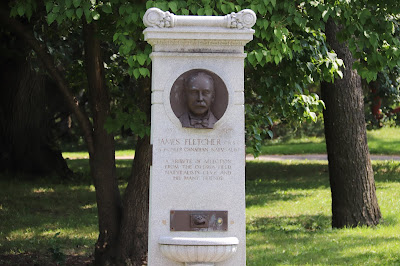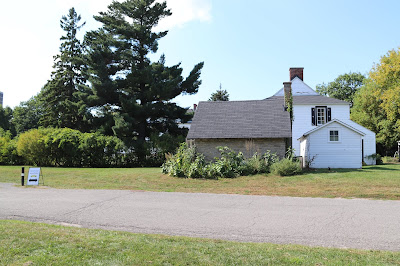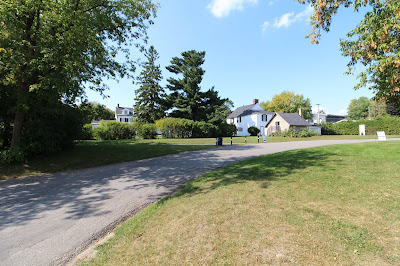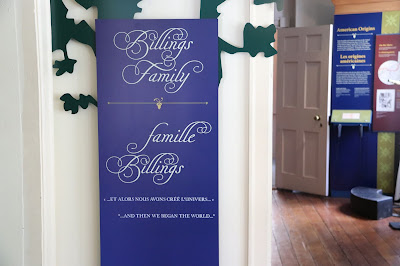Billings Estate occupies a location at the end of Cabot Street opposite where it adjoins the south side of Pleasant Park Road east of Riverside Drive.
Billings House, the prominent feature of Billings Estate, is one of Ottawa's oldest homes, built by Braddish Billings in 1828 and 1829 with modifications made to it into the early 1830s. The government of Canada designated the house a national historical site of Canada, on November 28, 1968, under the Historic Sites and Monuments Act.
Braddish Billings, born in Massachusetts in 1783, was the first settler of Gloucester Township in 1812, where his homestead formed the nucleus of Billings Bridge.
BRADDISH BILLINGS, sen.
BORN AT WARE, MASSACHUSETTS.
SEPT. 23, 1783.
DIED AT GLOUCESTER
APR. 3, 1864.
Deceased was the first settler in teh Township of Gloucester, where he came to reside in October 1812: six years before any other settler came to the Township and several years before any settlement was made where Ottawa City now stands.
A Natural Calling
Lamira Billings was a respected healer in the community. She collected plants from farm and field for homemade remedies to treat all manner of ailments — from coughs and colds to cancer.
The small gardens on the grounds today would not likely have been part of the landscape in Lamira's time. There is little evidence of any ornamental plantings near the house until well into the 20th century. However, a variety of the herbs and other flowers cultivated in these beds would have been grown in earlier days for cooking and for natural "cures."
Some of the Billings children and grandchildren may have joined Lamira on her countryside excursions. Several took a keen interest in natural history and made discoveries in botany, entomology and paleontology that earned them wide recognition.
Many of the beautiful trees around the yard were introduced in the 1960s. The lawns and gardens continue to provide a welcoming green-space for visitors to explore.
L'appel de la nature
Lamira Billings était une guérisseuse bien connue dans la région. À partir des plantes de la ferme et des
champs, elle concoctait des remèdes naturels pour guérir des maux aussi variés que la toux, le rhume ou le cancer.
Les petits jardins que l'on voit sur les terrains aujourd'hui n'étaient probablement pas là du temps de Lamira. Les premières tracs d'un jardin d'agrément apparaissent bien après le début du XXe siècle. Toutefois, plusieurs herbes et fleurs cultivées ici aoujourd'hui étaient utilisées à l'époque pour la cuisine et l'élaboration de « remèdes » naturels.
Certaines des enfants et petits-enfants de Billings ont sans doute accompagné Lamira lors de ses excursions en campagne. Plus tard, plusieurs d'entre eux ont développé un intérêt marqué pour l'histoire naturelle et se sont fait connaître pour leurs découvertes en botanique, en entomologie et en paléontologie.
Bon nombre des arbres magnifiques quu l'on trouve dans la cour ont été plantés durant les années 1960. Aujourd'hui, ces pelouses et jardins sont autant d'espaces verts mis à la disposition des visiteurs.
Feeding a City
In its heyday the Billings farm was a bustling place. Massive barns, several stables, storage sheds and a greenhouse once stood here surrounded by some 1200 acres of land. By the1850s, the farm had become one of the biggest in the Ottawa Valley.
The Billings hired dozens of workers to help grow an increasingly wide variety of fruits and vegetables, hay and grains. They kept bees and raised chickens, sheep, hogs, cattle, oxen and horses.
The family became a major player in the dairy industry producing impressive quantities of cheese and butter. By 1900 the Billings Brothers Farm, as it was then known, focused on industrial milk and cream production.
Today, some of the smaller outbuildings remain, including the smoke house, gatehouse and wood shed. Step inside the icehouse to learn about how essential ice was to the successful operation of the Billings' farm.
Nourrir une ville
Durant ses beaux jours, la ferme de Billings est très dynamique. On y trouve, entourés d'environ 1 200 acres de terres agricoles, d'immenses granges, plusieurs écuries des hangars et une serre. Dans les années 1850, la ferme est l'une des plus prospères de la vallée de l'Outaouais.
Les Billings emploient des dizaines d'ouvriers agricoles qui cultivent une gamme de plus en plus vaste de fruits e légumes, du foin et des céréales. Ils procèdent â l'élevage d'abeilles, de poulets, de moutons, de porcs, de bovins et de chevaux.
La famille, qui produit de grandes quantités de fromage et de beurre, devient un acteur majeur de l'industrie laitière. Au tournant de XXe siècle, la Billings Brothers Farm, comme on l'appelle alors, se spécialise dans la production industrielle de lait et de crème.
Aujourd'hui, certaines des plus petites dépendances demeurent, comme le fumoir, la guérite et le hangar à bois. Visitez la glacière pour saisir l'imporance de la glace pour l'exploitation de la ferme.
CREATIVE HANDS AT WORK
James Henry Blair built this bicycle by hand in 1878 at the age of seventeen.
With remarkable resourcefulness and ingenuity Blair fashioned the bike from materials found on his father's farm. Well-seasoned ash forms the frame and wheels and a hay binder supplied the chain an sprockets. The bedals came from a discarded "high mount bicycle" and a tire-like cover of leather once protected the wheels.
As a bicycle made of wood, Blair's invention is not entirely unique. During the mid-19th century, commercially availabale bicycles or velocipedes were built with wooden wheels and steel frames. Home-built models with wooden frames were also known to exist.
Later in the century, a worldwide growth in bicycle sales created a shortage of the steel tubing used in bicycle frame construction. Turning to the abundance of cheap hardwood available, Canadian manufacturers met rising demand by producing bicycles with wooden frames, handlebars and rims.
Today, home made wooden bicycles are found in use in Africa while all over the world wood working enthusiasts continue to build wooden bicycles as an art form.
James Henry Blair and his wooden bicycle
Courtesy of the Gloucester Historical Society
James Henry Blair et son vélo en bois
Prêt généreux de la Société Historique de Gloucester
DES MAINS CRÉATIVES À L'ŒUVRE
Cette bicyclette a été construite à la main en 1898 par James Henry Blair, alors âgé de 17 ans.
Remarquablement débrouillard et ingénieux, James Henry Blir a mis au point cette bicyclette à l'aide de matériaux trouvés sur la ferme de son père. Il s'est servi de frêne bien séché pour bâtir le cadre et les roues et du'une moissonneuse lieuse pour fabriquer la chaîne et les pignons. Les pédales provenaient d'un grand-bi (vélo à roue avant de très grand diamètre) mis au rancart, et un recouvrement de cuir faisant office de pneus protégeait autrefois les roues.
Le vélo de bois de M. Blair n'était pas tout à fait unique, car au milieu de XIXe siècle, les bicyclettes et vélocipèdes offerts sur le marché avaient des roues de bois et un cadre d'acier. On sait qu'il existait aussi des modèles artisanaux à cadre de bois.
Plus tard au courant du siècle, l'augmentation des ventes de bicyclettes à l'échelle mondiale a provoqué une pénurie de tubes d'acier utilisés pour la fabrication des cadres. Devant l'abondance de bois dur bon marché, les manufacturiers canadiens ont satisfait la demande en produisant des bicyclettes pourvues d'un cadre, s'un guidon et de jantes faites de cette matière.
De nos jours, des bicyclettes artisanales en bois sont encore utilisées en Afrique. Partout ailleurs, des amateurs d'ébénisterie en confectionnent encore, mais uniquement pour l'art.



































At the Heart of the Community
As a young man, Braddish Billings had left home to seek his fortune in lumbering when he came upon this choice piece of property at the edge of the Rideau River. He set down roots here building a rough-hewn shanty that served as a home while he worked the timber trade. A year later he replace it with a small log cabin where he and his young wife Lamira "began the world" together. As they acquired more land and succeeded at farming, they eventually were able to move their growing family up hte hill into the grand house behind you.
The Billings property became the centre of a burgeoning community that Lamira and Braddish helped develop. They ran a sawmill and an inn, operated a ferry to carry passengers and goods across the river, and led the effort to build a bridge that was later named for them. Billing Bridge provided a vital link with Bytown and its market where the Billings sold their produce. As the population of Bytown grew and market demand increased, the family prospered.

Au cœur de la collectivité
Ayant quitté son foyer dans l'espoir de faire fortune comme bûcheron, le jeune Braddish Billings s'intalle sur ce terrain de choix aux abords de la rivière Rideau. Il y a construit d'abord une cabane grossière qui lui sert de maison pendant qu'il fait le commerce du bois. L'année suivante, il la remplace par une petite cabane de rondisn où Lamira, sa jeune épouse, et lui « créent leur univers ». Ils élargissent et retabilisent leurs terres, puis sont en mesure de s'installer avec leur famille grandissante au haut de la colline, dans le manoir se trouvant derrière vous.
La demeure des Billings devient le centre d'une communauté forissante grâce à Lamira et Braddish. Ils exploitent un moulin à scie, une auberge et un traversier qui relie les rives de la rivière Rideau, permettant ainsi la circulation des gens et des biens. Ils contribuent aussi à la construction d'un pont qui porte leur nom. Le Billings Bridge constitue une voie essentielle vers Bytown et, sourtout, vers son marché où la famille vend ses fruits et légumes selon la demande. La richesse des Billings augmente alors au même rythme que la population de Bytown.





















































































































